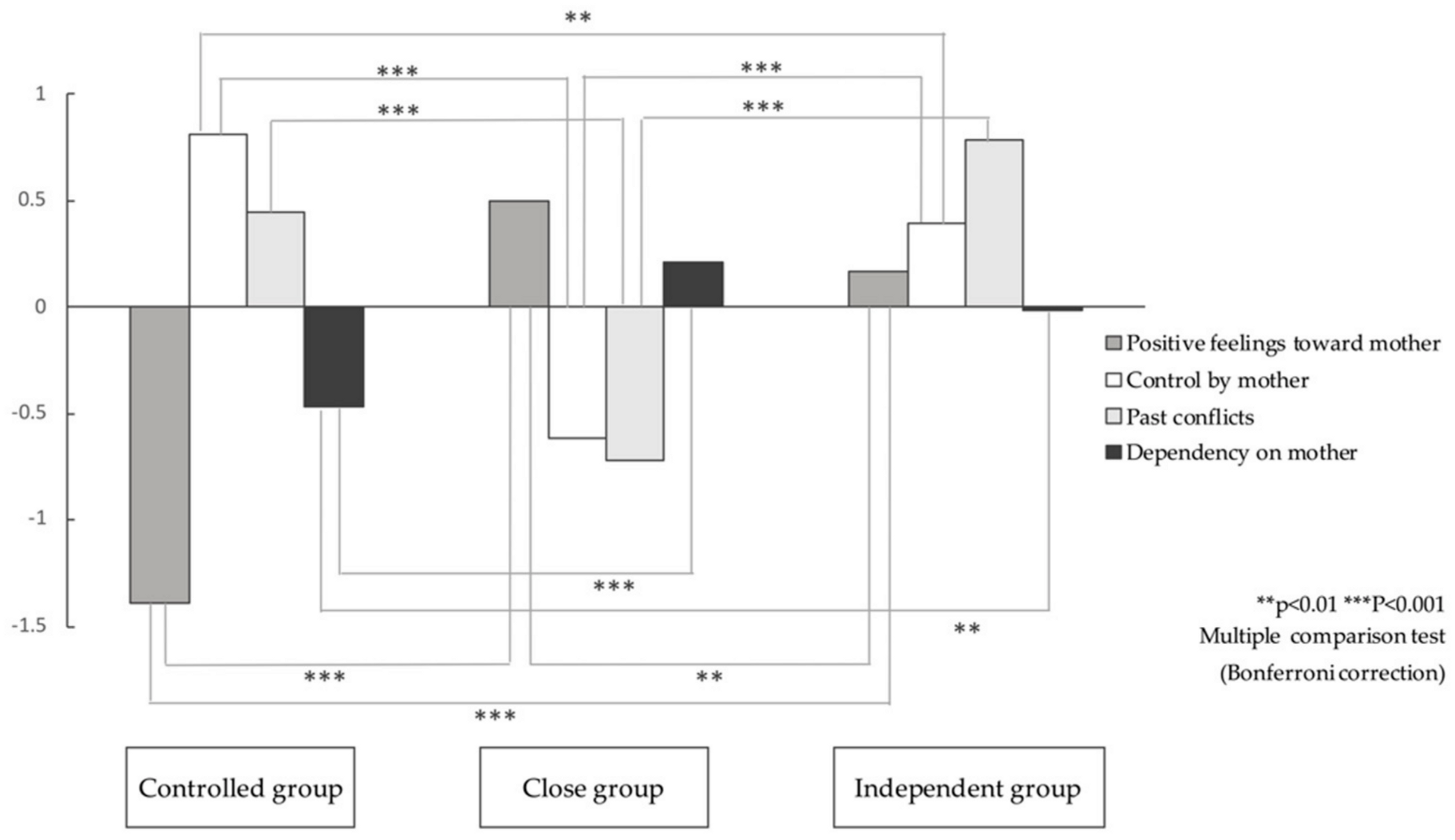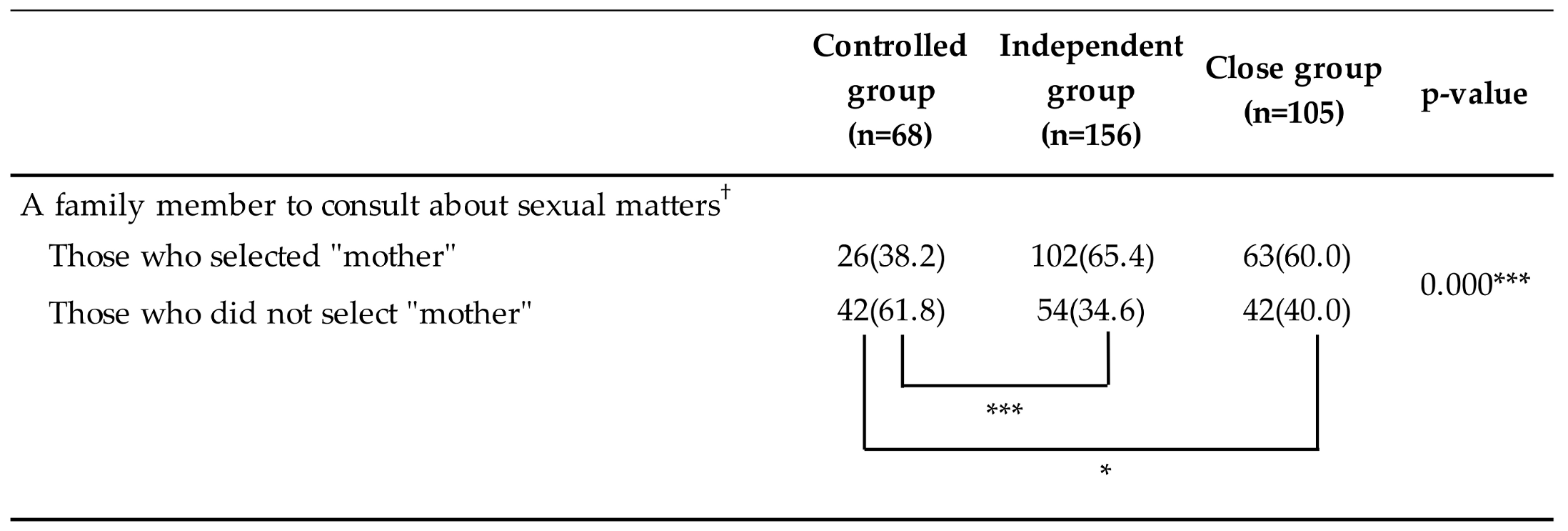Characteristics of Mother–Daughter Relationships and Sexual Risk-Coping Consciousness among Japanese Female University Students
Abstract
1. Introduction
2. Materials and Methods
2.1. Study Design
2.2. Participants and Procedures
2.3. Contents of Questionnaire
- (1)
- Basic attributes
- (2)
- Mother-daughter relationship scale [27]
- (3)
- Sexual risk-coping consciousness [26]
- (4)
- Actual sexual behaviors
2.4. Statistical Analysis
2.5. Ethical Considerations
3. Results
3.1. Characteristics of Participants
3.2. The Mother-Daughter Relationship Scale and Classification of Mother-Daughter Relationships
3.3. Sexual Risk-Coping Consciousness
3.4. The Degree of Respondents’ Consultation with Their Mothers about Sexual Matters in Each Mother-Daughter Relationship Cluster
3.5. Scores for Sexual Risk-Coping Consciousness in each Mother-Daughter Relationship Cluster
3.6. Sexual Behaviors by Mother-Daughter Relationship Cluster
4. Discussion
4.1. Basic Attributes of the Study Participants
4.2. Validity of the Mother-Daughter Relationship Classification and Characteristics of Each Cluster
4.3. Associations of the Characteristics of Mother-Daughter Relationships with Daughters’ Sexual Risk-Coping Consciousness and Sexual Behaviors
4.4. Limitations
5. Conclusions
Author Contributions
Funding
Acknowledgments
Conflicts of Interest
References
- Sagami Rubber Industries Co., Ltd. Nippon no Sex 2018 Ban. Available online: https://www.sagami-gomu.co.jp/project/nipponnosex2018/01_love_sex.html (accessed on 4 November 2020).
- The Japanese Association for Sex Education. “Wakamono No Sei” Hakusho: Dai 8 Kai Seisyounen No Seikoudou Zenkokucyousa Houkoku; Syougakukan: Tokyo, Japan, 2019; pp. 18, 70–81. [Google Scholar]
- Dentu Daivercity. Labo. LGBT Chousa. Available online: https://www.dentsu.co.jp/news/release/2015/0423-004032.html. (accessed on 4 November 2020).
- Sagami Rubber Industries Co., Ltd. Nippon no Sex. Available online: https://www.sagami-gomu.co.jp/project/nipponnosex/ (accessed on 4 November 2020).
- Ministry of Health, Labour and Welfare. Available online: https://www.mhlw.go.jp/topics/2005/04/tp0411-1.html (accessed on 4 November 2020).
- Ministry of Health, Labor and Welfare. Available online: https://www.mhlw.go.jp/toukei/saikin/hw/eisei_houkoku/18/dl/kekka6.pdf (accessed on 4 November 2020).
- Malekpour, M. Effects of attachment on early and later development. Br. J. Dev. Disabil. 2007, 53, 81–95. [Google Scholar] [CrossRef]
- Onodera, A. Comparative study of adolescent views on their parents and their self-reliance in Japan and the United States. Jpn. J. Psychol. 1993, 64, 147–152. [Google Scholar] [CrossRef][Green Version]
- Yamada, Y. Mother-Child Relation in Youth. Soc. Jpn. Psychol. Rev. 1988, 31, 88–100. [Google Scholar]
- Mizumoto, M. Examination of the Relationships Between Parents and Their Emerging Adult Children: Psychological Independence and Intimacy. Jpn. J. Educ. Psychol. 2018, 66, 111–126. [Google Scholar] [CrossRef]
- Kawata, K.; Shimamatsu, Y. Multiple Aspects of Expanding the Accuracy of Axillary Temperature Measurement Methods. Int. J. Nurs. Clin. Pract. 2018, 5, 1–7. [Google Scholar] [CrossRef]
- Andersen, M.R.; Leroux, B.G.; Bricker, J.B.; Rajan, K.B.; Peterson, A.V., Jr. Antismoking parenting practices are associated with reduced rates of adolescent smoking. Arch. Pediatr. Adolesc. Med. 2004, 158, 348–352. [Google Scholar] [CrossRef]
- Baker, S.D.; Quiñonez, R.B.; Boggess, K.; Phillips, C. Pregnant women’s infant oral health knowledge and beliefs: Influence of having given birth and of having a child in the home. Matern. Child Health J. 2016, 20, 1288–1295. [Google Scholar] [CrossRef]
- Weintraub, J.A.; Prakash, P.; Shain, S.G.; Laccabue, M.; Gansky, S.A. Mothers’ caries increases odds of children’s caries. J. Dent. Res. 2010, 89, 954–958. [Google Scholar] [CrossRef]
- Hughes, S.O.; Power, T.G.; O’Connor, T.M.; Orlet Fisher, J.; Chen, T.A. Maternal feeding styles and food parenting practices as predictors of longitudinal changes in weight status in Hispanic preschoolers from low-income families. J. Obes. 2016, 2016, 7201082. [Google Scholar] [CrossRef]
- Maness, S.B.; Buhi, E.R.; Daley, E.M.; Baldwin, J.A.; Kromrey, J.D. Social determinants of health and adolescent pregnancy: An analysis from the national longitudinal study of adolescent to adult health. J. Adolesc. Health 2016, 58, 636–643. [Google Scholar] [CrossRef]
- Panova, O.V.; Kulikov, A.M.; Berchtold, A.; Suris, J.C. Factors associated with unwanted pregnancy among adolescents in Russia. J. Pediatr. Adolesc. Gynecol. 2016, 29, 501–505. [Google Scholar] [CrossRef] [PubMed]
- Huq, M.N.; Tasnim, T. Maternal education and child healthcare in Bangladesh. Matern. Child Health J. 2008, 12, 43–51. [Google Scholar] [CrossRef] [PubMed]
- Mosley, M.; Delormier, T.; Banna, J. Food-related beliefs of adolescent girls ages 9–13 and their mothers on O’ahu, Hawai’i. Hawaii J. Med. Public Health 2016, 75, 101–108. [Google Scholar] [PubMed]
- E Silva, R.N.A.; Van de Bongardt, D.; Va de Looij-Jansen, P.; Wijtzes, A.; Raat, H. Mother- and Father-Adolescent Relationships and Early Sexual Intercourse. Pediatrics 2016, 138, e20160782. [Google Scholar]
- Samari, G.; Seltzer, J.A. Risky sexual behavior of foreign and native-born women in emerging adulthood: The long reach of mother-daughter relationship in adolescence. Soc. Sci. Res. 2016, 60, 222–235. [Google Scholar] [CrossRef]
- McCallister, C.J.; Akers, A.Y.; Worlds, A.D.; Morrison, P.K. Message About Contraception and Condoms in Mother-Adolescent Dynamic Conversation: Knowledge, Risks, and Effectiveness. J. Pediatr. Adolesc. Gynecol. 2019, 32, 395–401. [Google Scholar] [CrossRef] [PubMed]
- Widman, L.; Choukas-Bradley, S.; Noar, S.M.; Nesi, M.; Garrett, K. Parent-Adolescent Sexual Communication and Adolescent Safer Sex Behavior: A Meta-Analysis. JAMA Pediatr. 2016, 170, 52–61. [Google Scholar] [CrossRef]
- Song, S.; Kawabata, T.; Li, M.; Hishida, K.; Sakai, C.; Tsujimoto, S.; Nakamura, H.; Imade, Y. Longitudinal Study about Access to Sexual Content on the Internet and Sexual Behavior among Japanese Junior High School Students. Jpn. J. Sch. Health 2013, 55, 197–206. [Google Scholar]
- Johns Hopkins Medicine. Health. Safer Sex Guidelines. Available online: https://www.hopkinsmedicine.org/health/wellness-and-prevention/safer-sex-guidelines (accessed on 4 November 2020).
- Kusano, I. Sexual Risk-Coping Consciousness by Sexual Intercourse Experience. Jpn. Soc. Youth. Adolesc. Psychol. 2006, 18, 41–50. [Google Scholar]
- Fujiwara, A.; Ito, Y. Mother-Daughter Relationships between Late Adolescence and Early Adulthood. Jpn. Soc. Youth Adolesc. Psychol. 2007, 19, 69–82. [Google Scholar]
- Shimizu, H. An introduction to the statistical free software HAD: Suggestions to improve teaching. Learning and practice data analysis. J. Media Inf. Commun. 2016, 1, 59–73. [Google Scholar]
- R Core Team. R: A Language and Environment for Statistical Computing; R Foundation for Statistical Computing: Vienna, Austria, 2020; Available online: https://www.R-project.org/ (accessed on 4 November 2020).
- Ministry of Education, Culture, Sports, Science and Technology. Available online: https://www.mext.go.jp/b_menu/toukei/002/002b/1403130.htm (accessed on 4 November 2020).
- Japan Student Services Organization. Heisei28nendo Gakuseiseikatsuchousakekka. Available online: https://www.jasso.go.jp/about/statistics/gakusei_chosa/__icsFiles/afieldfile/2018/06/01/data16_all.pdf (accessed on 4 November 2020).
- Vigoureux, S.; Bajos, N.; Ringa, V.; FECOND Group. Effect of Parent-Daughter Communication about Sex on the Use of Less Effective Contraception among Women from Ages 15–24 Years in France. J. Pediatr. Adolesc. Gynecol. 2018, 31, 33–39. [Google Scholar] [CrossRef] [PubMed]
- Wang, B.; Stanton, B.; Deveaux, L.; Li, X.; Lunn, S. Dynamic Relationships Between Parental Monitoring, Peer Risk Involvement and Sexual Risk Behavior Among Bahamian Mid-Adolescents. Int. Perspect. Sex Reprod. Health 2015, 41, 89–98. [Google Scholar] [CrossRef] [PubMed]



| Attributes | Options | Minimum | Maximum | Mean ± SD | n (%) |
|---|---|---|---|---|---|
| Age | 20 | 27 | 20.9 ± 0.9 | ||
| Department | Medical | 224 (68.1) | |||
| Other | 105 (31.9) | ||||
| Family living together | Living alone | 141 (43.0) | |||
| (multiple answers) | Living with family | 176 (53.3) | |||
| Other | 12 (3.7) | ||||
| Family structure | Father | 286 (86.9) | |||
| (multiple answers) | Mother | 329 (100) | |||
| Experience of sexual intercourse | Yes | 175 (53.5) | |||
| No | 118 (36.1) | ||||
| No response | 36 (10.9) | ||||
| Age of first sexual intercourse encounter (n = 174 *) | 12 | 21 | 18.6 ± 1.6 | ||
| Sexual partner currently dating | Yes | 131 (39.9) | |||
| No | 181 (55.2) | ||||
| No response | 17 (5.2) | ||||
| Sexual partner currently not dating | Yes | 33 (10.8) | |||
| No | 251 (82.3) | ||||
| No response | 45 (13.7) | ||||
| Number of sexual partners currently not dating (n = 32 †) | 1 | 4 | 1.8 ± 1.0 | ||
| Frequency of contraceptive use | Every time | 119 (68.0) | |||
| (n = 175 ‡) | Almost every time | 39 (22.3) | |||
| Rarely | 10 (5.7) | ||||
| Never | 2 (1.1) | ||||
| Currently not engaged in sexual intercourse | 4 (2.3) | ||||
| No response | 1 (0.6) | ||||
| History of induced abortion | Yes | 1 (0.6) | |||
| (n = 175 ‡) | No | 172 (98.3) | |||
| Don’t want to answer | 2 (1.1) | ||||
| History of sexually transmitted infections (multiple answers) | Chlamydia | 2 (1.1) | |||
| Candida | 8 (4.6) | ||||
| Others § | 0 (0) | ||||
| (n = 175 ‡) | Never | 164 (93.7) | |||
| No response | 7 (4.0) | ||||
| Item | α |
|---|---|
| Factor 1: Positive feelings toward mother (10 items) | 0.88 |
| Factor 2: Control by mother (6 items) | 0.84 |
| Factor 3: Past conflicts (4 items) | 0.91 |
| Factor 4: Dependency on mother (4 items) | 0.77 |
| Item | α |
|---|---|
| Factor 1: Cooperative management type (6 items) | 0.82 |
| Factor 2: Active management type (6 items) | 0.75 |
| Factor 3: Self-management awareness (6 items) | 0.69 |
Publisher’s Note: MDPI stays neutral with regard to jurisdictional claims in published maps and institutional affiliations. |
© 2020 by the authors. Licensee MDPI, Basel, Switzerland. This article is an open access article distributed under the terms and conditions of the Creative Commons Attribution (CC BY) license (http://creativecommons.org/licenses/by/4.0/).
Share and Cite
Yamanaka, C.; Kawata, K. Characteristics of Mother–Daughter Relationships and Sexual Risk-Coping Consciousness among Japanese Female University Students. Int. J. Environ. Res. Public Health 2020, 17, 8795. https://doi.org/10.3390/ijerph17238795
Yamanaka C, Kawata K. Characteristics of Mother–Daughter Relationships and Sexual Risk-Coping Consciousness among Japanese Female University Students. International Journal of Environmental Research and Public Health. 2020; 17(23):8795. https://doi.org/10.3390/ijerph17238795
Chicago/Turabian StyleYamanaka, Chisato, and Kimiko Kawata. 2020. "Characteristics of Mother–Daughter Relationships and Sexual Risk-Coping Consciousness among Japanese Female University Students" International Journal of Environmental Research and Public Health 17, no. 23: 8795. https://doi.org/10.3390/ijerph17238795
APA StyleYamanaka, C., & Kawata, K. (2020). Characteristics of Mother–Daughter Relationships and Sexual Risk-Coping Consciousness among Japanese Female University Students. International Journal of Environmental Research and Public Health, 17(23), 8795. https://doi.org/10.3390/ijerph17238795





